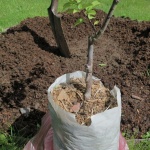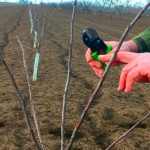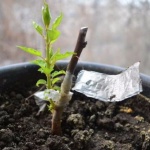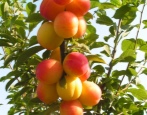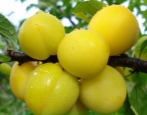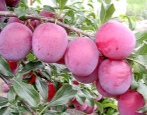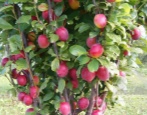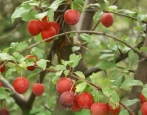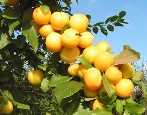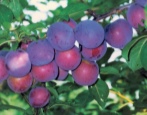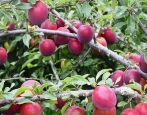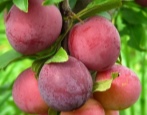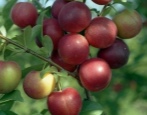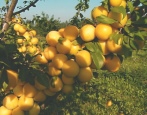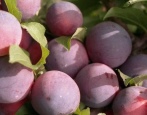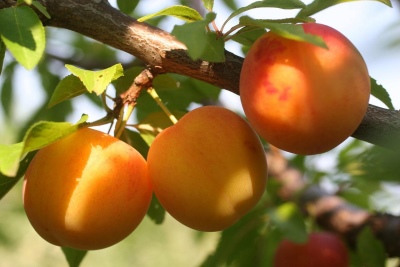
- Authors: A.V. Isachkin, N.V. Agafonov, B.N. Vorobiev (Moscow Agricultural Academy named after K.A.Timiryazev)
- Name synonyms: Prunus cerasifera Zlato Skifov
- Year of approval: 2005
- Growth type: medium-sized
- Ripening period: early
- Self-fertility: self-infertile
- Fruit size: large
- Yield: medium
- Appointment: universal
- Fruit weight, g: 36
The article presents material about the features of the Scythian cherry plum variety. This is a unique variety that has been gaining more and more popularity among gardeners in recent years.
Breeding history
The variety was bred in 1997 by breeders of the Moscow Agricultural Academy named after K. A. Timiryazev. In 2005 it was included in the State Register. To obtain a new variety, cherry plums, felt cherries, Ussuriyskaya, American and Chinese plums were used. The tree is grown mainly in temperate latitudes and in the south. The variety has gained recognition and popularity at the presentations of agricultural crops.
Description of the variety
The advantages of cherry plum include aesthetic appearance, original taste, unpretentious care, frost resistance. The particular advantage of the variety is its early harvest. The plant is successfully used for landscaping personal plots. It acquires a particularly aesthetic appearance during flowering. The abundance of delicate flowers, shimmering in the light in different shades, attracts insects. And also cherry plum looks exotic during fruiting: the tree seems to be covered with gold from bulk fragrant fruits.
The plant reaches a height of 3-4 meters. This variety of cherry plum is frost-resistant, tolerates frosts down to minus 30 degrees. At the same time, the quality of the bark does not suffer from frost, however, the tree is sensitive to repeated spring frosts, and flowers are especially sensitive to cold weather. The tree is resistant to fungal diseases.
Fruit characteristics
The fruits are large, oval-shaped, each weighing 35-40 grams. The color is golden. The stone is medium, it is separated with effort. The abdominal suture is poorly visible. A waxy coating is visible on the dense skin. Fruits can be stored for two to three weeks at temperatures from +5 degrees.
Taste qualities
The fruits have a special taste: the pulp is sweet, but with a hint of sourness. Fruit is used both unprocessed and as an ingredient in various dishes. You can make jam, preserves, compote, jam, marshmallow, pie fillings, marmalade and much more.
Ripening and fruiting
The variety brings rich harvests. Begins fruiting in late June - mid-July, which is one of the earliest indicators. Fruit ripening is uneven, consists of 2-3 phases, which alternate after 5-7 days. The plant begins to bear fruit in 4-5 years.
Yield
The tree brings about 20 kg of harvest. Under optimal conditions, up to 30 kg of fruit can be harvested.
Self-fertility and the need for pollinators
The plant is self-fertile. The following varieties are recommended for pollination: Rubinovaya, Pavlovskaya yellow, Gift to St. Petersburg. Pollination with other varieties of cherry plum and Chinese plum is also possible. The pollinator's flowering periods need to be matched. The formation of flowers in the described cherry plum falls on the last decade of April - the first half of May.
Growing and care
The fruit culture is quite unpretentious to care for. Grows well in neutral loamy soil. The variety is thermophilic, cherry plum will grow better in a place warmed by the sun and protected from the wind. Planting seedlings should be done in April, after the end of severe frosts and cold weather. If the seedling was purchased at the end of autumn, then it should be dug in before wintering, and planted in the spring. Autumn planting is acceptable in southern latitudes.
First, you should prepare a hole, the depth of which is about 60 cm, and the diameter is 65-70 cm. Then you need to prepare the soil, consisting of humus, peat and sand. A planting pit should be set up in a week or two. Also, organic and mineral fertilizers should be added to it.
The position of the root collar during planting should be 5 cm above the ground. Next, you need to fill the hole with prepared earth and intensively compact. If the seedling is weak, it must be attached to a nearby peg. The trunk should be surrounded by an embankment. Then there is abundant watering with 2-3.5 ten-liter buckets of water. Next, it is important to mulch the soil; straw or peat is suitable for this.
Water the plant as the soil dries out. Moderate watering should be provided to the plant during flowering and fruiting. Frequent wetting can be avoided during rainy seasons. The watering rate is 50-60 liters under the tree. Note that the recommended water temperature is around 25 degrees. In stable hot weather, watering should be limited to 3-4 times per season.
Fertilization should be applied regularly during the life cycle. Before the flowers appear, the soil is fed with potassium salt (40 g) and ammonium nitrate (25 g) per 1 m2. Digging is carried out under the plant. In May, urea must be added under the plant in a proportion of 10 g per 5 l of water. After flowering, top dressing is done with a solution of manure in a ratio of 1: 3. Next, superphosphate should be added to this mixture: dissolve 50 g in 10 liters (2 liters per 1 m2). In the first decade of June, the plant should be sprayed with 4% urea.
In autumn, the cherry plum should be watered with the prepared composition of fertilizers. To do this, prepare a solution of 2 tbsp. l potassium sulphide, 3 tbsp. l superphosphate and 10 l of water. The fruit tree is watered with 20 liters of the resulting solution.
A necessary step to increase yields is crown formation. Sanitary pruning is carried out in March. The sparse-tiered crown shape is a suitable option for pruning. In the first year, you need to arrange three branches with a distance of 20 cm between them, the required angle of inclination from the trunk will be 45-60 degrees. The angle between the branches is 120 degrees. The remaining branches are pruned at the level of the ring. The central conductor is pruned at level 3 of the skeletal branch. Slices are carefully covered with garden pitch. The crown needs to be formed for 3-4 years from the second year after planting.
